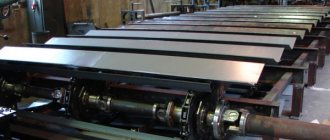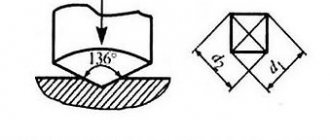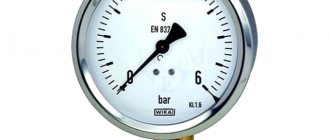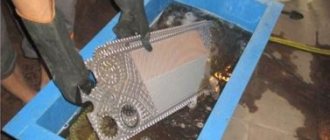Useful life
The calculation of depreciation of fixed assets is regulated by the Tax Code if a company, using depreciation deductions, reduces the income tax base. To correctly determine the useful life of an object (SPI), a classifier is needed. The directory states that machines for processing concrete belong to the fifth group, the service life is 7-10 years. Within this framework, you can select the accrual period.
If depreciation is needed for management accounting, the company can set this period itself. The shorter it is, the larger the amount of depreciation will be redistributed to costs, this can lead to an increase in product costs. Conversely, if the period is chosen to be very long, the equipment may fail before it is completely depreciated. Calculating depreciation of fixed assets involves different methods, but a company can choose only one of them. You can change the method once every five years.
Deductions begin from the next month after purchase. If Betoniya bought the machine in July, then the first accrual will be made in August.
WHAT IS THE DIFFERENCE BETWEEN WEAR AND DEPRECIATION?
There is often an equal sign between wear and depreciation, considering these concepts to be equal. Let us immediately emphasize that this is a fundamentally erroneous view.
Under ideal conditions, wear and tear will be equal to depreciation, but even in this case these are two different economic processes. The difference between them is that depreciation is based on the process of transferring the value of an asset to the cost of products, works, and services. And this process often does not correspond to the real wear and tear of the object, as a result of which the asset, its components, and assemblies lose their original qualities or lag behind modern technical requirements (become obsolete).
For example, during downtime for production reasons, physical wear and tear will stop, there may be no obsolescence, but depreciation will still be charged.
How is depreciation calculated?
Depreciation can be calculated according to accounting or tax accounting rules.
Using two methods for calculating depreciation simultaneously (one for accounting purposes, the other for tax accounting purposes) complicates accounting work and increases the labor intensity of the process. Therefore, separate methods of calculating depreciation are used only if there are serious reasons for this.
What is the economic meaning of this complication?
The economic meaning of this complication arises, for example, when property tax is calculated according to accounting data, and not according to the cadastral value. In this case, the additional difficulties are offset by property tax savings.
Also, such double accounting is carried out if the purposes of tax and accounting accounting are different. Tax accounting is usually aimed at legally minimizing a company's tax obligations, accounting - at maximizing financial performance.
If there are no grounds for conducting double accounting, then it is better to calculate depreciation according to the norms of the Tax Code of the Russian Federation, thereby bringing accounting and tax accounting closer together.
How to calculate depreciation?
The essence of depreciation is that the initial cost of an asset is written off, i.e., transferred in parts to cost, during the useful life of this asset and terminates after 100% of the cost of this asset is written off to cost.
The useful life of an asset is determined by the taxpayer on the date of commissioning of this depreciable property, taking into account the Classification of fixed assets[1].
The main task in relation to this document is to determine which depreciation group this asset belongs to, after which the useful life becomes clear automatically.
The depreciation groups identified in the Classification of Fixed Assets contain instructions not on the exact useful life, as was the case before the introduction of this legislative act, but on a range of periods.
Accordingly, if the maximum period of the range is selected, then writing off depreciation on the asset will take longer, and the accrual of depreciation in early reporting periods will be at a reduced rate compared to if the minimum period of the range was selected.
Who chooses the depreciation period? Enterprises do this independently based on the requirements of management, the economic situation and other factors. It is advisable to reflect the choice in the accounting policies of the organization.
Example 1
The group of companies is engaged in the production of footwear. In order to optimize tax obligations, the group includes an enterprise on the general taxation system (OSNO) and an enterprise on the simplified taxation system (STS).
To avoid accusations from the tax authority of illegal tax optimization in the form of business fragmentation, each company has its own management, its own staff and its own consumers. Also, organizations are geographically distant from each other, do not have common office premises or financial flows.
To finance a new expensive investment project, an organization that is part of the group and uses the simplified tax system tries to attract investors and for this, in agreement with the founders, tries to maximize its net profit. One of the mechanisms for improving financial reporting indicators is the use of maximum useful life ranges.
To find out how the use of maximum useful lives of fixed assets will affect the financial result of the organization, the economic service made a comparative calculation, the results of which are summarized in table. 1.
According to the accounting policy, the company applies the maximum useful lives of assets within the legally established range of useful lives. The annual amount of depreciation in this case is RUB 2,190,547.80.
If the organization applied minimum useful lives, the annual amount of depreciation charges would be RUB 3,198,072.41.
The difference is 1,007,524.61 rubles. and represents the value of the annual economic effect from using the maximum useful life of the equipment.
This difference will not affect the tax obligations of the enterprise, since the company applies the simplified tax system, which provides for a special procedure for accepting expenses on fixed assets for tax accounting.
But the reporting will include a net profit figure of RUB 1,007,524.61. longer than would be the case if minimum useful lives were applied.
This impact on the final financial result will have a positive effect in negotiations with investors.
For tax accounting purposes, enterprises have the right to choose one of the methods of calculating depreciation - linear or non-linear.
Linear method
Used in tax and accounting. Payments are made evenly throughout the entire period of use. Formula for calculation:
Deductions = Initial cost: SPI in months
For the brick making machine, the SPI of 8 years or 96 months was chosen.
500,000.00 : 96 = 5,208.33 (rub.)
And this is what the table of annual accruals will look like:
What is wear and tear
Fixed assets, being repeatedly used in the production process, retain their characteristics for some time, and then begin to gradually lose them due to exploitation and natural factors.
Depreciation of fixed assets is the process and result of partial or complete loss of their technical characteristics and qualities, consumer properties, residual value, occurring as a result of operation and/or inaction (under the influence of time).
Nonlinear method
Can be used in tax accounting, but not in accounting. Does not apply to objects of 8-10 groups from the classifier, for example, real estate. The cost of fixed assets of one group is summed up, and depreciation is charged immediately to the entire group:
Deductions = Cost of the fixed assets group x Depreciation rate
The brick making machine belongs to the fifth group; the company has only one machine, so the calculation is carried out only for it. The depreciation rate for a brick making machine is 2.7. Depreciation is calculated every month and reduces the cost of the asset every month. In the first year, deductions will amount to 139,982.11 rubles, which is almost twice as much as with the first method. In the month following the moment when the total cost of the fixed assets group becomes less than 20,000 rubles, the company can write it off one-time.
Reducing balance method
For the calculation, an accelerating factor from 1 to 3 and the residual value of the fixed asset at the beginning of the year are used. "Betonia" chose a maximum acceleration factor of 3.
Deductions = Residual value of fixed assets: SPI in months x Acceleration factor
500,000.00: 96 x 3 = 15,625.00 (rub.) - deductions in the first year of use (from August 2022 to July 2022).
500,000.00 - (15,625.00 x 12) = 312,500.00 (rub.) - residual value as of August 1, 2022.
Each year, contributions will decrease, from August 2022 to July 2023 they will be:
312,500.00: 96 x 3 = 9,766.00 (rub.)
If at the end of the depreciation period there remains an unwritten-off amount, it can be included in deductions for the last month or depreciation can be charged at 582 rubles before the amount is completely written off. Another option is to increase depreciation charges in the last year, paying not 582 rubles monthly, but 1552 (divide 18,626.45 rubles by 12 months).
Ministry of Economic Development and Trade of the Russian Federation
Order
June 1, 2015 No. 328
On approval of the federal valuation standard “Assessment of the cost of machinery and equipment (FSO No. 10)”
In accordance with Article 20 of the Federal Law of July 29, 1998 No. 135-FZ “On Valuation Activities in the Russian Federation” (Collected Legislation of the Russian Federation, 1998, No. 31, Art. 3813; 2006, No. 31, Art. 3456; 2010 , No. 30, Art. 3998; 2011, No. 1, Art. 43; No. 29, Art. 4291; 2014, No. 30, Art. 4226) I order: 1. Approve the attached Federal valuation standard “Valuation of machinery and equipment (FSO No. 10)". 2. This order comes into force on the date of entry into force of the orders of the Ministry of Economic Development of Russia dated May 20, 2015 No. 297 “On approval of the Federal Valuation Standard “General Concepts of Valuation, Approaches and Requirements for Valuation (FSO No. 1)”, dated May 20 2015 N 298 “On approval of the Federal Valuation Standard “Purpose of Valuation and Types of Value (FSO No. 2)”, dated May 20, 2015 N 299 “On approval of the Federal Valuation Standard “Requirements for the Valuation Report (FSO No. 3)” .
Minister A.V. ULYUKAEV Approved by order of the Ministry of Economic Development of Russia dated June 1, 2015 No. 328
Federal valuation standard “Evaluation of the cost of machinery and equipment (FSO No. 10)”
I. General provisions
1. This Federal Valuation Standard has been developed taking into account international valuation standards and federal valuation standards “General concepts of valuation, approaches and requirements for valuation (FSO No. 1)”, “Purpose of valuation and types of value (FSO No. 2)”, “Requirements for assessment report (FSO No. 3)" (hereinafter referred to as FSO No. 1, FSO No. 2, FSO No. 3), other federal assessment standards governing the assessment of certain types of assessment objects, approved by the Ministry of Economic Development of Russia, determines the requirements for assessing the value of machines and equipment.
2. If the object of assessment in the assessment assignment is not directly machinery and equipment, but machinery and equipment are part of the assessment object, then this Federal Assessment Standard applies to the assessment procedure for such machinery and equipment only when the assessment assignment provides for the use of this Federal assessment standard indicating the list of machinery and equipment to which these requirements apply.
3. The provisions of this Federal Valuation Standard do not apply to the valuation of intangible assets associated with the creation and operation of machinery and equipment; machines and equipment of artistic and (or) historical value, as well as work and services to eliminate damage resulting from emergency situations (for example, damage from vehicle accidents).
4. If the operation of machinery and equipment is impossible without the use of intangible assets (software, specialized databases, licenses, technical documentation, etc.), then, depending on the assessment task, the cost of intangible assets should be taken into account separately or as part of the cost of machinery and equipment.
II. Objects of assessment
5. For the purposes of this Federal Valuation Standard, the objects of valuation include individual machines and pieces of equipment that are products of mechanical engineering production or similar to them, groups (sets, aggregates) of machines and equipment, parts of machines and equipment together or separately (hereinafter referred to as machines and equipment ).
For the purposes of this Federal Assessment Standard, the objects of assessment may be aircraft and sea vessels, inland navigation vessels, and space objects subject to state registration.
III. Assessment task
6. The assignment for the assessment of the assessment object must contain the following information about the assessment object, additional to that specified in FSO No. 1:
• the composition of the evaluated group of machines and equipment, indicating information on each machine and piece of equipment sufficient for their identification;
• information on accounting for intangible assets necessary for the operation of machinery and equipment (if such assets exist).
7. The assignment for the assessment of the assessment object may contain the following additional information to that specified in FSO No. 1 in terms of assumptions on which the assessment should be based:
• assumption associated with limiting the scope of work to inspect the machines and equipment being assessed;
• assumption related to the limitation of the scope of work on market analysis;
• assumption of the valuation of machinery and equipment as a whole, subject to their continued use as part of the existing property complex;
• assumption of the valuation of machinery and equipment as a whole, subject to the cessation of their use as part of the existing property complex;
• assumption of valuation of machinery and equipment subject to movement from their current location as separate objects;
• in the case of integrated machinery and equipment with other objects, in particular real estate, an assumption about the valuation of machinery and equipment as part of such objects or separately from them.
8. The assessment task establishes the level of detail of the inspection work (full, partial with criteria, without an inspection) and the inspection period. In case of failure to carry out an inspection, the appraiser indicates in the assessment report the reasons why the object of assessment was not inspected, as well as the assumptions associated with the failure to carry out the inspection.
9. In the absence of documented encumbrances in relation to the appraisal object, the appraisal of the object is carried out based on the assumption of the absence of such encumbrances, unless otherwise specified in the appraisal task.
IV. Market analysis
10. To assess the cost of machinery and equipment, the appraiser examines the market in those segments in which the most significant part of the assessed machinery and equipment can be sold. Segments of both the primary and secondary markets are examined, if these types of markets exist for the valuation object.
V. Approaches to assessment
11. For an assessment object, which is a set of machines and equipment, both individual and mass assessment methods can be used. For the purposes of this Federal Valuation Standard, mass valuation of machinery and equipment is understood as an assessment of the value of many machinery and equipment by grouping them according to similar characteristics and using general mathematical models within the formed groups. The final result is the value of the valuation object as a whole.
12. When evaluating machinery and equipment using cost and comparative approaches, it is allowed to use price information about events that occurred with similar objects after the valuation date, for example, through reverse price indexation. In this case, the appraiser must analyze price dynamics from the valuation date to the date of the relevant event and make appropriate adjustments. The use of such price information is permissible if the appraiser carries out and discloses in the report an analysis of the obtained calculated values for compliance with market indicators prevailing on the date of assessment, and also specifies the assumptions associated with the use of this information.
13. In the presence of a developed and active market for analogue objects, which makes it possible to obtain the necessary amount of data on the prices and characteristics of analogue objects for assessment, a conclusion can be drawn that it is sufficient to use only a comparative approach. The lack of market information necessary for the comparative approach is a reason not to use it.
14. When applying the cost approach to the valuation of machinery and equipment, the appraiser takes into account the following provisions:
a) when evaluating specialized machinery and equipment, it is advisable to use a cost approach. Specialized machines and equipment are a set of technologically related objects that are not presented on the market as an independent object and have a significant value only as part of a business;
b) the costs of reproduction of machinery and equipment (without taking into account wear and tear and obsolescence) are determined on the basis of comparison with the costs of creating or producing or purchasing an exact copy of the valuation object. The costs of replacing machinery and equipment (without taking into account wear and tear and obsolescence) are determined based on comparison with the costs of creating or producing or purchasing an object that has similar useful properties;
c) an exact copy of the valuation object for the purposes of assessing machinery and equipment is recognized as an object that has at least the following characteristics identical to the valuation object: name, model (modification) designation, main technical characteristics;
d) an object that has similar useful properties, for the purposes of assessing machinery and equipment, is recognized as an object that is similar to the object of assessment in terms of functionality, principle of operation, design design;
e) when applying the cost approach, the accumulated cumulative depreciation of the valued machine or piece of equipment is calculated, integrating physical wear and tear, functional and economic obsolescence, taking into account the features of impairment under different operating conditions, as well as taking into account the accepted assumptions on which the assessment is based, focusing as much as possible on market data.
15. When applying the income approach to the valuation of machinery and equipment, the appraiser takes into account the following provisions:
• the income approach to the valuation of plant and equipment can be used where the benefits distributed over time from its use can be valued in monetary terms, either directly, or as a corresponding part of the benefits generated more directly, or as a corresponding part of the benefits generated by a wider set of objects , including the object being assessed and producing a product (goods, work or service).
VI. Coordination of assessment results
16. Coordination of the results of the assessment of machinery and equipment obtained using various methods and approaches to assessment, and the reflection of its results in the assessment report are carried out in accordance with the requirements of FSO No. 1.
VI. Final provisions
17. In case of discrepancies between the requirements of this Federal Valuation Standard with the requirements of FSO No. 1, FSO No. 2, FSO No. 3 and other federal valuation standards governing the evaluation of certain types of valuation objects approved by the Ministry of Economic Development of Russia, this Federal Standard takes precedence.
Write-off method based on the sum of years of use
An accelerated method that writes off most of the cost of the OS in the first years of use. Calculation of depreciation of fixed assets is carried out on the basis of the original cost and the sum of the remaining years of useful life.
Depreciation rate = Remaining SPI: Sum of SPI years x 100%
Sum of SPI years = 8 + 7 + 6 + 5 + 4 + 3 + 2 + 1 = 36
Depreciation rate (first year) = 8: 36 x 100% = 22.2%
Depreciation rate (second year) = 7: 36 x 100% = 19.4%
Deductions = Initial cost x Depreciation rate
500,000.00 x 22.2% = 111,111.11 (rub.) - the amount of depreciation for the first year;
111,000.00: 12 = 9,259.26 (rub.) - monthly deductions in the first year.
Wear rate analysis
Here are several criteria that should be followed when assessing and analyzing a wear indicator:
- an increase in the coefficient indicates that the time for modernization or replacement of fixed assets is approaching;
- a value of 50% is considered a “turning point”: after overcoming this mark, it is recommended to make management decisions on the renewal of fixed assets;
- It is recommended to calculate the depreciation coefficient simultaneously with the serviceability coefficient of fixed assets.
Write-off method in proportion to production
The calculation will require the initial cost of the OS, planned and actual performance. The brick making machine produces 450 units of paving slabs per hour. The company plans to use it 7 hours every workday. Over the entire period of operation in this mode the following will be produced:
450 pieces x 7 hours x 240 working days x 8 years = 6,048,000 (pieces)
Depreciation per thousand pieces = 500,000.00: 6,048 = 82.67 (rub.)
If the company produces 78,000 units of paving slabs in a month, the deductions will be:
78 x 82.67 = 6448.41 (rub.) - depreciation for the month.
This method allows you to take into account depreciation relative to actually produced products, but incorrect planning can lead to distortion of depreciation charges, so it is better to use it for operating systems with a small TPI. It is, of course, difficult to predict the future, but let’s assume that the machine worked very well and produced the planned volume of production in 7 years. Depreciation stopped accruing, its book value became zero.
Alexander Pyatinsky, chief accountant of LANIT OT Group:
“Calculating depreciation of fixed assets is a simple and effective planning tool in management accounting. The requirement to compare received income and expenses allows you to evenly distribute the financial result through depreciation. The choice of method depends on what business model is used in the company: - the linear method is suitable for companies with activities that are not subject to seasonal fluctuations; — writing off the cost in proportion to manufactured products may be suitable for those who enter the market with an innovative product; — when a company needs to recognize more expenses in the first years than in subsequent years, the reducing balance method is suitable. The chosen method must be fixed in the accounting policy and be consistent in its application. You cannot use different methods for the same type of asset. A common problem with depreciation is low-value fixed assets. Often monitors and laptops costing less than 40,000 rubles in accounting are written off as expenses rather than depreciated. If there are only a few such assets, this is not significant, but for companies where IT equipment plays an important role, this becomes a problem."
Calculation of depreciation of fixed assets in management accounting
The company compared different calculation methods:
- Linear turned out to be the simplest: write-offs are the same throughout the entire period.
- With the non-linear method, depreciation dragged on for ten years, until the residual value of the fixed assets became less than twenty thousand rubles, in order to write it off one-time.
- The reducing balance method allows you to write off the largest amount in the first year, but every year, in August, the amount of deductions decreases, this needs to be controlled.
- The write-off method based on the sum of years of useful use has the same drawback, but it, the only one of the accelerated ones, allows you to write off the entire amount proportionally during the self-employment period, without a balance in the last month.
- Write-off in proportion to manufactured products allows you to understand what the share of depreciation in the cost price is, but for equipment with a long period of time, it may not be suitable.
As a result, the linear method of calculating depreciation was chosen. The company chooses how to account for depreciation. You can record the accrual on paper, come up with a table in Excel, or use a ready-made solution. In the PlanFact service you can conveniently calculate depreciation. Every month the owner will see exact numbers in the financial reports:
- in the income statement - correct profit;
- on the balance sheet - the residual value of the fixed assets.
The balance sheet, which reflects the receipt of a loan and the purchase of a brick making machine, looks like this:
500,000 rubles (the initial cost of the brick making machine) are reflected in “Fixed assets” and “Long-term liabilities”. After accruing depreciation of 5,200 rubles, the cost of fixed assets in the balance sheet will change:
494,800 rubles is the residual value of the brick making machine. The amount of deductions can be seen in the income statement:
A sinking fund is not an abstract concept, but a special account, preferably with interest on the balance to cover inflation. The company can transfer money into it once a month or allocate a certain percentage of profits from each trade, periodically checking the income statement to control the size of the fund. If equipment requires replacement or repair, you can use money from the sinking fund to avoid taking out a loan.
Physical and moral wear and tear
There are two forms of depreciation of fixed assets - physical and moral.
Physical wear and tear – loss of consumer value
When fixed assets are affected by various physical forces, as well as technical and economic factors, including storage conditions, the assets gradually fail, lose value and sooner or later must be replaced. In some cases, physical wear and tear must be restored through, for example, major repairs.
For each group of fixed assets, the form of manifestation of physical wear and tear will differ in its characteristics:
- equipment and tools during wear can change shape, size, performance, accuracy, etc.;
- buildings and structures undergo physical wear and tear more slowly;
- transfer devices lose their quantitative and qualitative characteristics as their service life expires;
- production and household equipment wears out most quickly.
Physical deterioration is an uneven process, since factors that are not always predictable affect different types of assets differently. Characteristic pattern of wear rates:
- at the beginning of operation - more accelerated wear;
- during the main service life - a slight slowdown in the pace due to the establishment of a working rhythm;
- towards the end there is acceleration again.
The forms of physical wear and tear may vary depending on the characteristics of the degradation and its completeness.
- Depending on the impact of certain factors on the fixed asset, the following are distinguished:
- mechanical wear;
- decrease in key indicators over time of use;
- wear and tear of inactive assets under the influence of storage conditions and natural factors (humidity, fungus, etc.).
- Depending on the degree of wear, we can distinguish:
- partial wear and tear is a loss of value and properties that can be compensated by repairs, returning a significant part of the original characteristics to the fixed asset;
- complete wear and tear - the fixed asset is subject to replacement (reimbursement) by purchasing a new one (equipment, tools, etc.) or capital construction (buildings and structures).
Obsolescence - you can use it, but it’s no longer worth it
Obsolescence shows the loss of value of fixed assets that are physically still suitable for use, but are already less profitable due to the emergence of other, more efficient types. Depreciation can be considered a synonym for obsolescence.
Forms of obsolescence vary according to its underlying causes.
- In the context of scientific and technological progress, the cost of reproduction of fixed assets is becoming cheaper. Manufacturers of fixed assets are increasing their capacity and modernizing their enterprises, as a result of which new equipment and tools are beginning to cost less than their analogues that have been used for some time and are still physically suitable for use. The decrease in value occurs due to the fact that the cost of living labor for the production of certain fixed assets is reduced. In this case, the consumer properties of the assets are, as a rule, preserved.
- New technologies and equipment models are emerging that make it possible to produce more products with the same labor costs. More modern tools, equipment, vehicles, etc., which are more economical, will reduce the cost of production, that is, they will surpass the old one that is still working in qualitative and/or quantitative parameters.
- Social wear and tear occurs when the characteristics of a fixed asset that are relevant to society exceed the acceptable social level (for example, the level of safety, harmful emissions, etc.).
NOTE! Obsolescence does not always mean the need to replace fixed assets.










